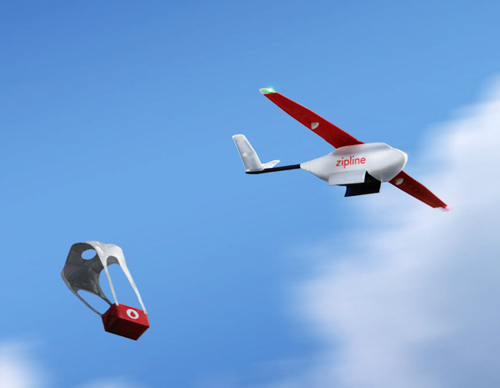The East-African country Rwanda is seen as the most progressive nation in Africa nowadays, with an average growth of 7.3% since 2000 and one of the most advanced countries world-wide in terms of gender equality. The most progress can be seen in the capital city, Kigali, where more and more digital start-ups set up their base to a compromising path. Rural areas in Rwanda, however, have seen a slower progress, especially regarding infrastructure and healthcare. With maternal deaths and malaria-induced anaemia as being the top causes for death in Rwanda, blood transfusions are crucial for the patients to survive. In the past, the infrastructure, however, has allowed blood deliveries from the capital city to rural hospitals only to happen within a couple of hours – too long for many patients. (Zipline, 2018)
This is why the Silicon Valley robotics company Zipline got together with the Rwandan health ministry to improve chances of life of millions of Rwandans: Drone blood deliveries to 12 regional hospitals within a maximum of 30 minutes. Making it as easy as possible, rural hospitals can order blood via SMS or WhatsApp to Zipline’s base in the Eastern part of the country before the drones fly autonomously to the dedicated hospitals, dropping the blood with the help of small parachutes. With 5500 blood deliveries in Rwanda in 2017, Zipline currently plans to expand to Tanzania, the “world’s largest drone delivery network” (McVeigh, 2018). It also wants to start delivering antimalarials, HIV medication and other lifesaving medication in the coming year. (McVeigh, 2018)
The Zipline case shows: Technology has met national commitment to improve healthcare and provide access to health and medication to everyone. While most Western countries are still trying to figure out how to use their air space and overuse time in testing, Rwanda has shown the world how to save lives, today.
Zipline Inc (2018). Zipline — Our Impact — Thousands of units of blood have been delivered and every delivery has a story. [online] Available at: http://www.flyzipline.com/our-impact/ [Accessed 30 Sep. 2018].
McVeigh, K. (2018). ‘Uber for blood’: how Rwandan delivery robots are saving [online] Available at: https://www.theguardian.com/global-development/2018/jan/02/rwanda-scheme-saving-blood-drone [Accessed 30 Sep. 2018].


Very interesting post. It is very refreshing to see this technology being used to enhance access to medicine in African countries. This initiative is heavily inline with the EC/ACP/WHO Renewed Partnership project’s goal of increasing access to medicine in African countries. Current life expectancy in african countries are on average 10 years less than the global average, with deaths partially caused by treatable diseases we can hope to see an increase in life expectancy. Hopefully, upon the success of this initiative it will spread to more and more African countries and reach other developing countries in need of better access to medicine.
Additionally, on the success of the drone technology to deliver products. Large online retailers will see the potential of using widespread drone delivery systems in busy cities to deliver their products. This option will serve as a huge competitive advantage as the e-commerce business can shift from ‘same day or next day delivery’ to ’30 minutes to 8 hour delivery’ availability.
Hi Daniel,
Wow, 10 years life expectancy less on average is a lot – let’s hope we can use technology to help people that don’t have the means to be treated immediately and qualitatively. I have seen that using drone deliveries of e-commerce shops has been developed in the Western World, and I am very curious to see how things will work out! Western countries oftentimes having strict guidelines on their air space, there must be a lot of regulation included. Thank you, Daniel!
Very interesting article Nicole. The healthcare industry has not been subject to many architectural changes yet, but it seems there is already a shift from hospital to remote (home) care. On top of the drone delivery you mentioned, consultations could be made remotely through ultra-HD video and AI systems could assist in diagnosis. Exciting stuff!
Hi Arthur, thanks for your input on this topic! In my research I indeed came across an increasing demand of home care, especially with such a demographic change happening at the moment. I think especially for developing countries this is an incredible development and can really save lives with little effort (once established). Things like ultra-HD videos are exactly what I mean here. Thank you!